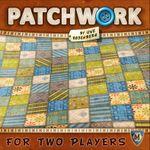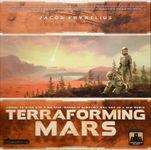
Patchwork
Patchwork is a two-player abstract strategy game where players compete to create the most aesthetically pleasing and efficient quilt by purchasing and arranging various fabric pieces on a personal game board.
How Complex is Patchwork?
Patchwork is easy to learn and play, with simple rules and a short playtime. However, strategic decision-making can be challenging for new players.
How much Luck is involved in the gameplay of Patchwork?
Luck plays a minor role in Patchwork as players have control over their own board and the availability of fabric pieces is predetermined. However, the starting player and piece selection can impact strategy.
How much Player Interaction does Patchwork offer?
Patchwork has limited player interaction as players focus on building their own quilt and do not directly affect their opponent's board. However, there is indirect competition for fabric pieces and strategic blocking can occur.
How much Replayability does Patchwork offer?
Patchwork offers moderate replayability due to the randomized selection of fabric pieces. Additionally, the game's short playtime and simple rules make it easy to play multiple times in one sitting.
Why you should play Patchwork
Unique gameplay
Patchwork is a two-player game that offers a unique gameplay experience. Players compete to create the best quilt by strategically placing different shaped pieces on their board.
Easy to learn
The game is easy to learn and can be played by anyone, regardless of their experience with board games. The rules are simple and straightforward, making it a great game for beginners.
Quick to play
A game of Patchwork typically takes around 30 minutes to play, making it a great option for a quick game night or when you don't have a lot of time to spare.
Strategic depth
Despite its simplicity, Patchwork offers a lot of strategic depth. Players must carefully consider their moves and plan ahead to create the best quilt possible.
Beautiful artwork
The game features beautiful artwork and high-quality components, making it a pleasure to play and display on your shelf.
Replayability
With a variety of different shaped pieces and a randomized starting layout, each game of Patchwork offers a unique experience, ensuring that you'll want to play it again and again.
Why you should avoid Patchwork
Limited player count
Patchwork is designed for two players only, so if you're looking for a game that can accommodate more players, this may not be the best choice.
Theme may not appeal to everyone
The theme of Patchwork revolves around quilting, which may not be of interest to everyone. If you're looking for a game with a more exciting or action-packed theme, Patchwork may not be the best fit.
Limited interaction between players
While Patchwork is a competitive game, there is limited interaction between players. This may not be ideal for those who prefer games with more player interaction.
May not be challenging enough for experienced gamers
While Patchwork offers strategic depth, it may not be challenging enough for experienced gamers who are looking for a more complex game.
Limited variability
While each game of Patchwork offers a unique experience, the variability may not be enough for some players who prefer games with more variability and replayability.
Where to play Patchwork online?
- Board Game Arena - https://en.boardgamearena.com/gamepanel?game=patchwork
- Android & iOS apps - https://www.asmodee-digital.com/en/patchwork/
Where to find the Rules of Patchwork
Check the rules of Patchwork in a PDF file.
You can also find the community-driven rules summary, player aid, etc., in the Patchwork files section on the BoardGameGeek website. You need an account on BGG to download files.
Beginner Strategies for Patchwork
These strategies are for players who have either not played or played one or two games of Patchwork.
Focus on getting as many buttons as possible
Buttons are the currency in Patchwork, and they are essential for buying new patches. Try to prioritize patches that give you buttons, and aim to fill in as many spaces on your board as possible.
Plan ahead
It's important to think ahead when playing Patchwork. Consider which patches you want to buy and where you want to place them on your board. Try to leave spaces open for larger patches that will give you more points.
Keep an eye on your opponent's board
Pay attention to your opponent's board and their progress. If they are close to completing a row or column, try to block them by taking the patches they need.
Aim for a high score
Focus on earning buttons and completing your board. Try to fill in as many spaces as possible and aim for a high score at the end of the game.
I hope these strategies help you in your first game of Patchwork!
Advanced Strategies for Patchwork
Prioritize patches that give you an advantage
As you become more familiar with the game, you'll notice that some patches let you take an extra turn or claim a special patch. Try to prioritize these patches when necessary, as they can give you a significant advantage.
Keep track of the time track
The time track is an important aspect of Patchwork, as it determines the turn order and the number of buttons you receive at the end of your turn. Keep track of where you are on the time track and try to time your moves accordingly.
Use the special patches to your advantage
The special patches can be a great way to fill in gaps on your board or to block your opponent. Don't be afraid to use them strategically, even if they don't give you any buttons or an advantage.
Consider the long-term effects of your moves
As you become more experienced with Patchwork, you'll start to think more about the long-term effects of your moves. Consider how each patch you place will affect your future moves and try to plan accordingly.
Be flexible
While it's important to have a plan in Patchwork, it's also important to be flexible and adapt to changing circumstances. If your opponent blocks you or takes a patch you wanted, don't panic - other options are always available.
I hope these strategies help you improve your gameplay in Patchwork!





